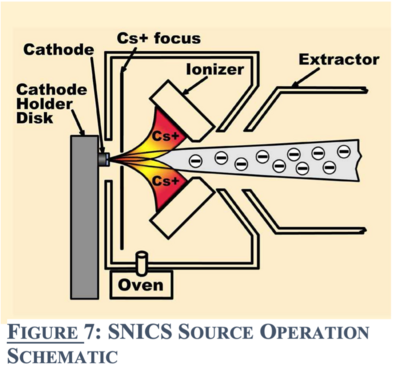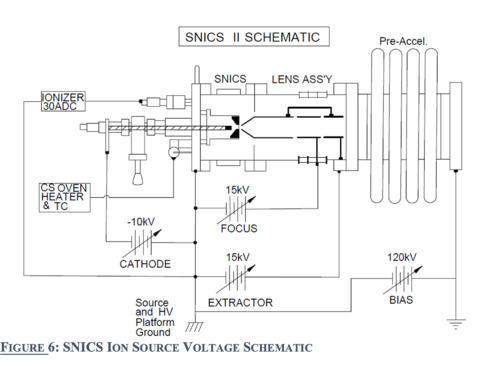Ion Sources: Difference between revisions
No edit summary |
|||
| Line 47: | Line 47: | ||
== Shutdown and Disassembly == | == Shutdown and Disassembly == | ||
= RF Source = | |||
== Operation Principle == | |||
Revision as of 17:40, 8 April 2022
Sputter Source
Sputter Source is also called SNICS.
Operation
The Source of Negative Ions by Cesium Sputtering (SNICS) produces a negative ion beam. A reservoir of cesium metal is heated so that cesium vapor is formed. This cesium vapor comes from the cesium oven into an enclosed area between the cooled cathode and the heated ionizing surface. Some cesium condenses onto the cool surface of the cathode and some of the cesium is ionized by the hot surface. The positively charged ionized cesium accelerates towards the cathode, sputtering material from the cathode at impact. Some materials will preferentially sputter neutral or positive particles which pick up electrons as they pass through the condensed cesium layer on the surface of the cathode, producing the negatively charged beam.
Tuning Beam out of the SNICS Source
These instructions assume the correct cathode is installed and the necessary hardware/cable changes for selecting an ion source has been made. Also assumed is that the source has been turned down after a previous run but not necessarily to the idle mode. Do not inject more than 10 microamperes of beam into the accelerator under any circumstances.
- Open the source exit valve in the Tandem Vault.
- Insert the L.E. faraday cup and depress the corresponding push button on the integrator panel. Select the most sensitive scale on the integrator initially and then adjust the scale if and when the beam current pegs the meter.
- In the Control Room, turn the ion source deflectors to zero.
- heater current to increase the beam current; do not exceed 290 watts or premature failure of the heater will occur. If there is still insufficient beam current, increase the cesium boiler temperature in 100◦ steps separated by 45 minute intervals. Do not exceed 490◦ or the cesium vapor will cause internal arcing in the source. If there is too much beam, reduce the boiler temperature and monitor the beam current. If less beam is still desired reduce the Ionizer heater current in Turn on and bring up the Preaccelerator High Voltage Supply to 120 KV.
- Adjust the inflector magnet supply to indicate the predicted setting for the negative ion that is to be injected into the Tandem. A table is provided on the inflector control panel.
- If the beam has been run before and the source parameters are known, adjust the SNICS Cathode and Extractor supplies to those values at the High Voltage Cage out in the Tandem Vault. If the Ionizer heater is to be adjusted do it in 4 ampere steps separated by 4 minute intervals.
- If no parameters have been recorded or cannot be found set the SNICS Cathode and Extractor supplies to 7.5 KV.
- Beam should be present on the L.E. cup; if not, adjust the inflector magnet slightly and attempt to find and maximize beam current. The inflector magnet should not be more than 0.15 units off of the predicted setting.
- An iterative approach is used to maximize beam on the L.E. cup. After the magnet is fine tuned, adjust the SNICS Cathode and Extractor supplies in the Tandem Vault to maximize beam current. When satisfied, again adjust the inflector magnet in the Control Room and then the source H.V. supplies again. After this second round of tuning use the source deflectors in the Control Room to increase beam current on the L.E. cup. More rounds of adjustments should be attempted; however, maximum beam transmission through the Tandem does not occur at the same settings as those for maximum L.E. faraday cup beam current. Mostly the source deflectors and the inflector magnet require slight readjustment when tuning through the Tandem.
- Assuming all the focusing and deflector elements are maximized for beam current, one can only adjust the Ionizer heater and the boiler temperature to attain more beam form the source. First increase the Ionizer one ampere steps until the desired current is reached. The beam is ready for injection.
Should one not have success with tuning the desired beam, reducing the ion source deflectors to 50% of the optimum for a couple of iterations of source voltages and inflector magnet adjustments might be a useful approach. Ultimately, the deflectors should be adjusted to give the maximum beam on target.
Typical Cathode Behavior
Most often the material packed into the SNICS cathodes is either a solid or powder. In general new, unused cathodes are often found to require more time to reach the output level of cathodes that have seen previous use. The nature of the material and how it was stored, particularly if it is a hygroscopic or deliquescent, can be of paramount importance when investigating a low negative ion output. Most powdered cathodes are pressed here in the lab and are inherently “gassy” due to voids in the pressed material. The solid material cathodes are the preferred cathode whenever possible. To reduce “damage” to the cathodes while they are not in use it is imperative that the cathodes be wrapped tightly in aluminum foil and placed in a tightly capped bottle that has been back filled with argon.
Solid cathodes when initially inserted into the source, assuming it is suitable material (ice cubes don’t work well), will outgas in a very short period of time. Beam from the ion source can typically be had in sufficient quantity in the time it takes the ionizer and boiler temperatures to be brought to the typical operating values.
Powder cathodes work best when they are pressed with dry powder and stored in a dry environment. These cathodes will take longer to outgas than their solid counterparts and the ion source extractor and cathode voltages will often suffer stability problems. Previously used cathodes, especially depending on the nature of the material, can sometimes take up to half a day to behave in a stable fashion and produce the desired beam current.
Temporary Turn Down
When a break or interruption occurs during the process of data collection and the use of the negative ion source will not be required by the experimental group for four or more hours it is desirable to turn down the source to prolong its operational life time.
- Turn down and off the preaccelerator high voltage supply in the Control Room.
- In the Tandem Vault, close the source exit valve.
- Reduce the Cesium Boiler Heater to 35 on the variac scale by turning the control rod located at the high voltage cage.
- Reduce the ionizer heater current in four ampere steps separated by two minute intervals to fifteen amperes by turning the control rod attached to the ionizer power supply located at the high voltage cage.
- Note in the Tandem Log Book, located in the Control Room, the time the source was turned down to the idle mode.

